Eyepiece Occulting Bar
Posted: 1 March 2024
What is an Occulting Bar?
An Occulting Bar is used to block light from a bright object that is in the eyepiece field-of-view (FOV) to let you see (and photograph) fainter objects that are very close to the bright object. Objects that benefit from using an Occulting Bar are Earthshine when the Moon is well past a crescent phase, faint nebulae or galaxies near a bright star, the Martian moons Phobos and Deimos when Mars is at a close opposition, Sirius B (the "Pup Star"), and close double stars.
The Occulting Bar is a thin piece of opaque material placed at an eyepiece "field stop" that partially covers the eyepiece FOV. It can be a narrow strip placed across the center of the FOV or a larger piece that covers up to one half of the FOV.
There are two basic requirements: 1) the material must be opaque, and 2) the edge must not be fuzzy.
Adding an Occulting Bar
As a rainy day project I added an Occulting Bar to an old Meade 1.25" Super Plössl 26mm eyepiece (yields 94X on my 12" f/8 LX600 telescope).
I first read the following articles to better understand adding an Occulting Bar. It was a lot simpler than I expected.
https://www.astroleague.org/files/u220/Occulting%20Eyepiece.pdf
https://www.cloudynights.com/topic/617490-occulting-bar-eyepiece/
https://www.oreilly.com/library/view/astronomy-hacks/0596100604/ch04s09.html
I unscrewed the silver 1.25" tube from the eyepiece to get access to the eyepiece field stop. There is no need to remove the field stop cyclinder itself. The 26mm eyepiece is on the left in the photo below. As I intended to add an Occulting Bar to an old Meade 1.25" MA 9mm eyepiece, it is shown on the right.
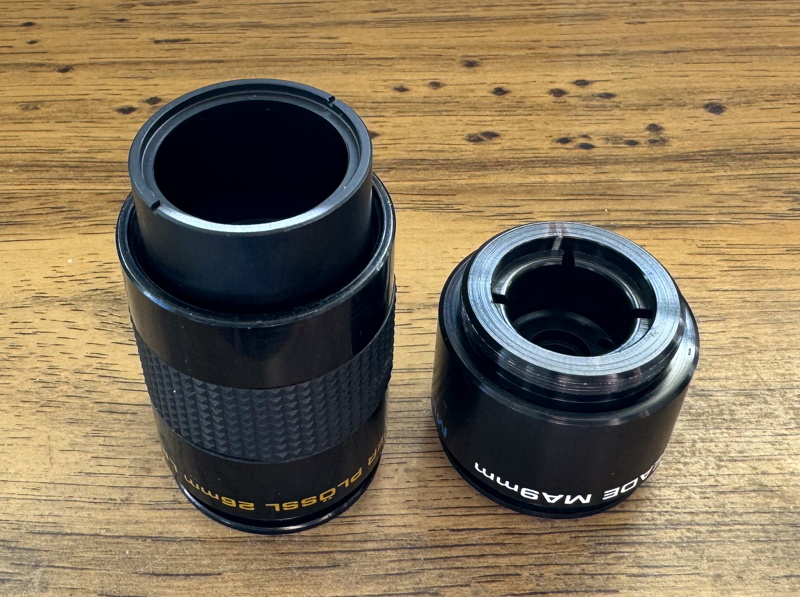
Next, I placed a small strip of aluminum foil at the field stop and trimmed off excess foil. The 26mm eyepiece was easy to do as there was sufficient area to attach the foil.
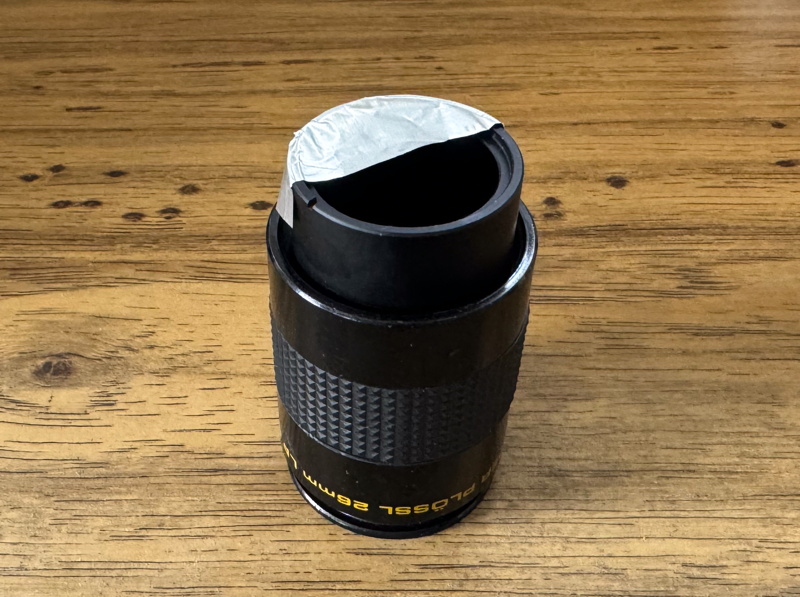
Once I was satisfied with the placement of the foil that blocked approximately half the field-of-view, I used a small piece of Scotch tape to affix the foil in place. I looked through the eyepiece to confirm that the foil was in focus (it was). Had it not been in focus, I would have carefully pushed (or pulled) on the edge of the foil while looking into the eyepiece until the edge was in focus.
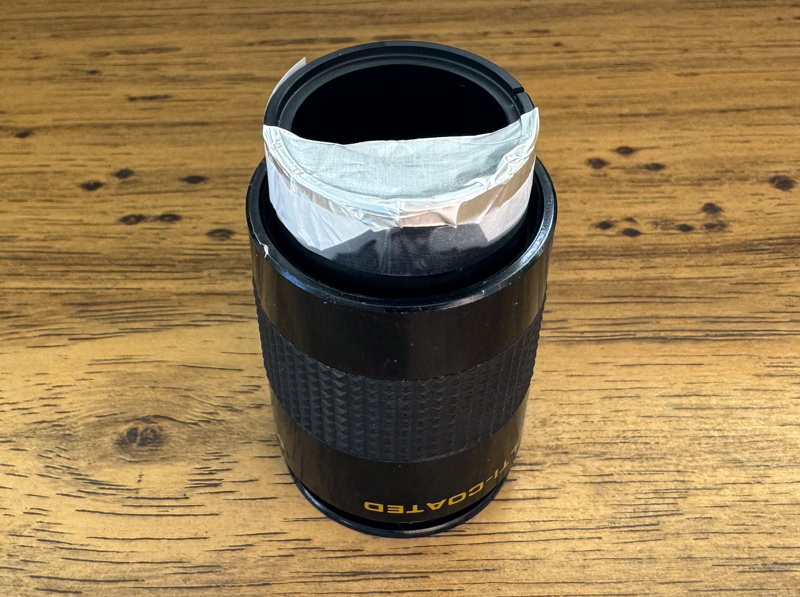
At this stage I did not blacken the aluminum foil to eliminate light scattering. I will do that if necessary after testing the Occulting Bar on Sirius A to see how it performs for observing Sirius B (the "Pup Star"). (Subsequent tests did not indicate a need to blacken the foil.) The black on the left side in this photo is the occulted side, with the sky on the right.
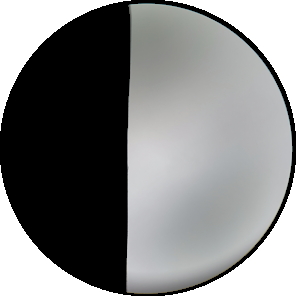
I then attached the silver tube. I found it best to hold the silver tube in one hand and use the other hand to rotate the eyepiece tube. NOTE: Before reattaching the silver tube to an eyepiece, tighten the field stop cyclinder if necessary.
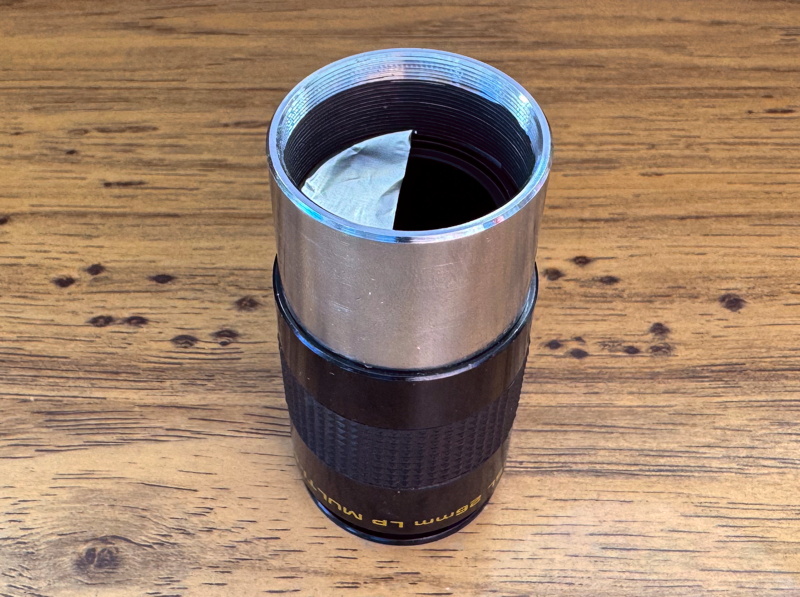
I also tried to add an Occulting Bar to the 9mm eyepiece, but several factors made getting a usable view of the Bar impossible. While the field stop was accessible on this eyepiece, the silver tube is threaded directly onto the end of the field stop cylinder, the "in focus" position was significantly recessed into the eyepiece tube, and the eyepiece exit pupil was small. If I need more magnification when viewing an object with the 26mm eyepiece Occulting Bar, I will add a Barlow Lens or Powermate.
How the Occulting Bar performed
Since this was initially a rainy day project, I had to wait before the sky was clear. On my first clear night I used the Occulting Bar to view NGC2024 (Flame Nebula). The star Alnitak hampered the view of the closeby nebula, but with the star blocked by the Occulting Bar, the Flame Nebula looked much better. I then viewed the double star Rigel and used the Occulting Bar to block Rigel making it's companion star more easily seen. Rigel and its companion are separated by approximately the same distance as Sirius A and Sirius B. I then slewed to Sirius and began trying to see Sirius B (the "Pup Star"), 94X. I could not see it. I added a 2" 2X Powermate for 188X, but Sirius B was still not visible. I would try again on a night of better seeing conditions when Sirius was higher in the sky.
On my second clear night I first did some tests using a Collimating Mask, both without and with the 26mm Occulting Bar eyepiece, while viewing Sirius. With the Mask I could not see Sirius B using a 24mm eyepiece (102X) or with the 26mm Occulting Bar eyepiece (94X). I removed the Mask and did some more tests on Sirius with the 26mm Occulting Bar eyepiece (94). I added a 3X Telenegative (281X). I also tried with a 4X Powermate (375X). No matter what magnification was used, Sirius B was not visible with the Occulting Bar.
I then used the 26mm Occulting Bar eyepiece while viewing the Earthshine on the Moon. With the Bar blocking the illuminated crescent phase, details on the Moon's surface from Earthshine were easier to see. I took these handheld iPhone 15 Pro Max photos using the NightCap Camera app (Earthshine: ISO 4000, 1/11sec, 1X lens; Crescent: ISO 55, 1/250sec, 1X lens).
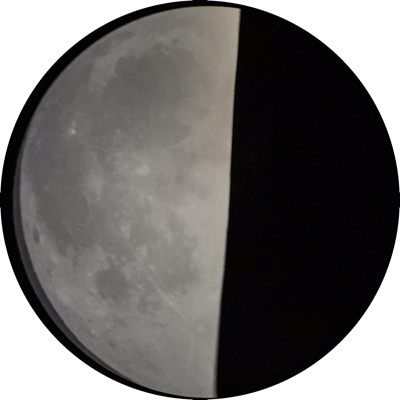
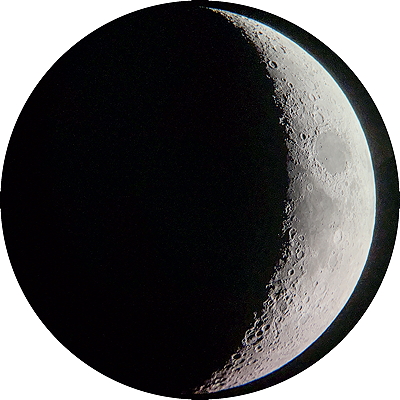
Subsequent attempts to view the "Pup Star" were on nights of a waxing Moon, up to a night when it was nearly Full. The Moon may have interferred with seeing the star.
But finally on 29 February 2024, on a moonless night with Sirius near the Meridian, I briefly could see Sirius B at times, 375X. I mounted an iPhone 15 Pro Max on the 26mm eyepiece using the Accuview 3-Axis Smartphone Adapter and attempted to take an afocal 375X image showing the Pup Star using NightCap Camera (ISO 10000, 1 second, 1X lens).
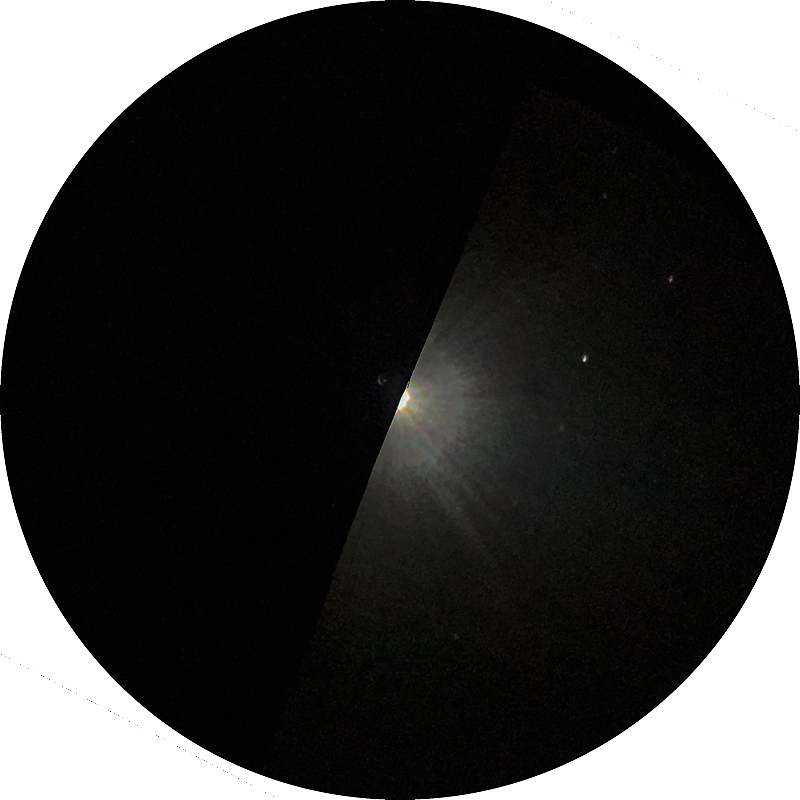
Mouseover or tap on image for pointer to possible Pup Star
Compare the above image to the reversed chart below.
Sirius B ("Pup Star") Charts
As noted in the Sky & Telescope article "SIRIUS B — A NEW PUP IN MY LIFE", Sirius A is Magnitude –1.46 and Sirius B (the "Pup Star") is +8.4, a difference in brightness of 10,000 times.
For those wanting to try to see the "Pup Star", here are charts of the current position of Sirius B as would be seen in a high magnification (375X) eyepiece, along with some background stars.
Magnification 375X, normal
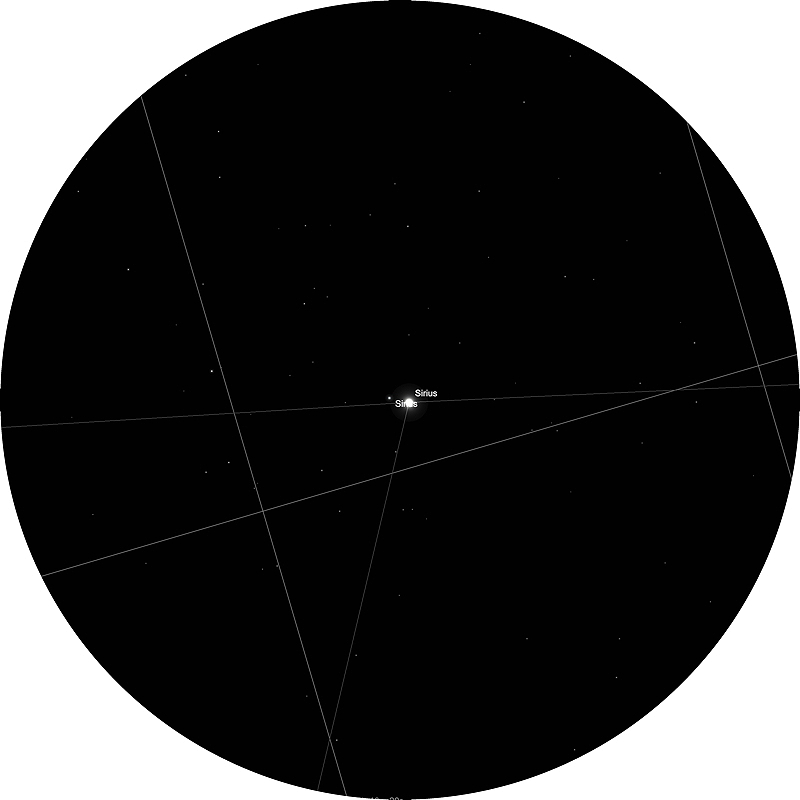
Magnification 375X, mirror reversed
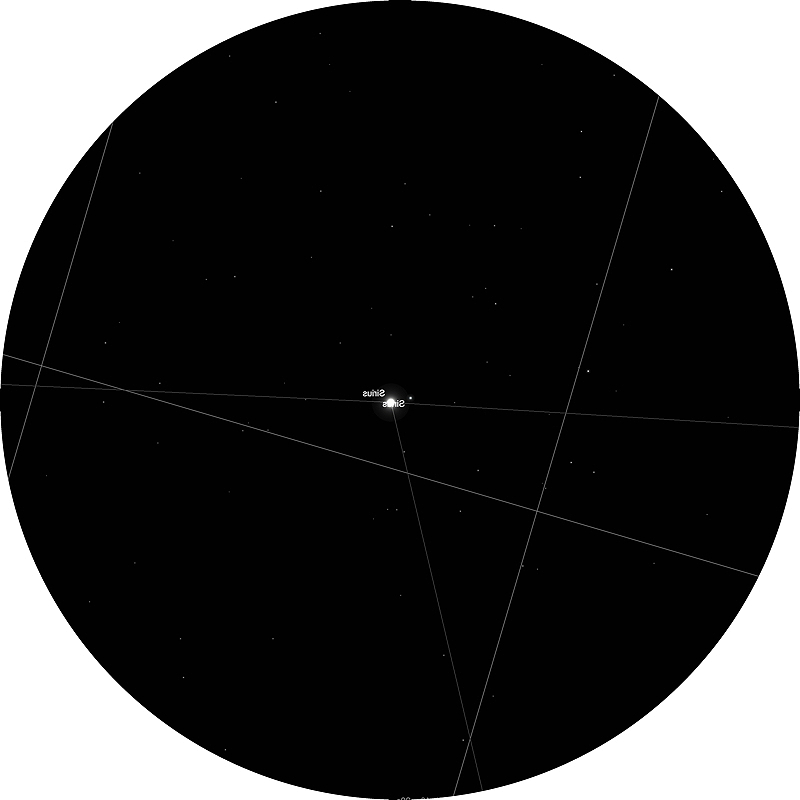
Occulting Bar Eyepiece Summary
Adding an Occulting Bar of the style I describe is fairly easy for some types of eyepieces. It will prove useful when observing some objects.
The best chances to view/photograph the Sirius B "Pup Star" with an Occulting Bar Eyepiece will occur on nights with excellent seeing when Sirius is near the Meridian, away from sources of Light Pollution, and when there is no interference from a bright Moon. In addition, clean optics are required.
Comments are welcome using Email.
Cassiopeia Observatory Home Page
Copyright ©2024 Michael L. Weasner / mweasner@mac.com
URL = http://www.weasner.com/co/articles/Occulting_Bar/index.html
